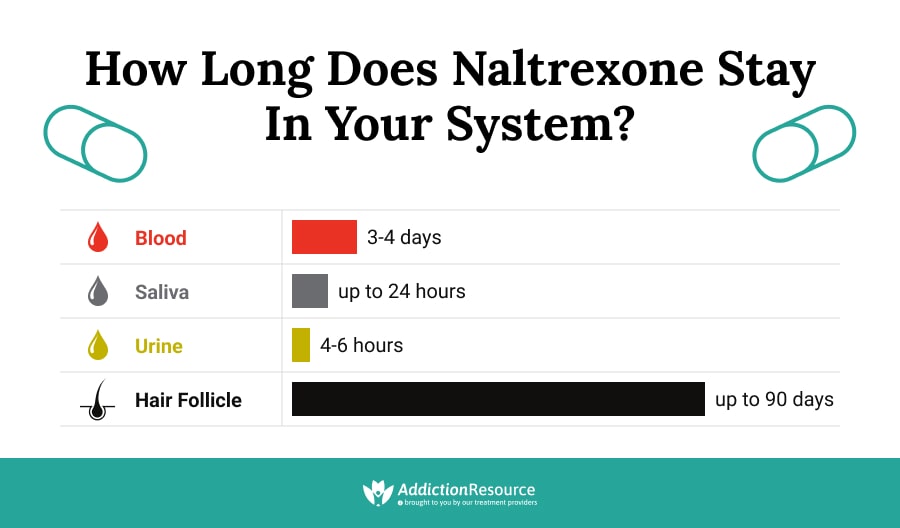Naltrexone, coming under the brand name Vivitrol and ReVia, is an opiate antagonist which is used to combat opiate addiction. People taking it often wonder how it affects the body and health, how long does it take for low-dose Naltrexone to work, and how long does Naltrexone last? Naltrexone Half-Life depends on many factors, especially the chemical composition, formulation, and route of entry.
Table Of Contents:
In this article pharmacokinetics, Naltrexone Half-Life and drug testing are discussed for detailed alleviation of these queries.
Naltrexone Half-Life: How Long Does Naltrexone Stay In Your System?
The half-life of the medicine strongly depends on how the medication is delivered. Oral Naltrexone HCL is metabolized to 6-β-naltrexol, its primary active metabolite. 6-β-naltrexol has a half-life of 13 hours. This way, a patient only must take one ReVia 50 mg pill daily to achieve sufficient and stable concentrations of the medication. At the same time, the half-life of Vivitrol (an injectable form of the medication) is 5-10 days. The injectable form of drug provides a steady release of the drug into the person’s system that lasts for approximately a month. The extended Vivitrol half-life is particularly convenient for patients who don’t wish to pop a pill daily for a significant period of time.

How Long Does Naltrexone Last?
People often ponder how long does Naltrexone stay in your system? The time during which the medication stays active or, at least, detectable in a person’s system is determined by Vivitrol dosing and the way of administration, and the person’s health. When the drug is injected, it is active in a patient’s system for a month. Oral Vivitrol has to be consumed daily. LDN half-life is the same as the conventional Naltrexone half-life. However, its elimination will take less time since the initial amount of the medication is approximately 1/10 of the ordinary dose.
How Long Does It Stay In Blood System
Oral Vivitrol can be detected in blood for up to 24 hours after a person took the last dose. The elimination might take longer if the patient is older or has a slower metabolism. Also, trace amounts of the medication can be present in a person’s system for as long as 3-4 days after the last 50 mg dose was ingested.
How Long Does It Stay In Urinary System
The drug can be detected in urine for 4 to 6 hours after it was consumed. However, it does not mean that the medication stops working after this period. It stays in the system and continues to exert influence long after it becomes undetectable in the urine. It is an important thing to remember when an interaction between Vivitrol and alcohol or other substances needs to be considered.
How Long Does It Stay In Saliva
Saliva is produced by parotid, submandibular and sublingual glands. Certain drugs like opioids, amphetamine can be tested by screening saliva. Similarly, Ingestion of the medicine can also be screened by oral fluids. It can also be used to test the residual of ingested drugs. A saliva test can help detect Vivitrol 24 hours after a person took the last dose.
How Long Does It Stay In Hair
Hair follicles act as a storage unit. A small amount of ingested drug is deposited along the growth line. This deposition can be used to measure the duration of drug intake and extract information about the quantity of drugs intake. Vivitrol stays in hair follicles for the longest. It can be detected for approximately 90 days after a person took the last dose of the medicine. Even after that time, It can still be detected in some of the hair until metabolized completely.
Naltrexone Mechanism Of Action
Naltrexone is a drug used in the treatment of opiate addiction and narcotic dependence. It is an opioid antagonist which is also used for the treatment of opioid overdose and to support recovery from narcotics addiction. It is a pure opiate antagonist which means it has no agonist activity. Although the exact Naltrexone mechanism of action is not completely understood, it is thought to be working by acting as a competitive antagonist at opiate receptor sites on cell surfaces. It competitively binds to all the opiate receptors including mu, K, and gamma with the highest affinity for mu receptors. This binding antagonizes the opioid response and helps in the treatment of opium overdose, dependence and supports recovery from drug abuse. In small doses, it also works as a pain relief medication by releasing endorphins which are a potent natural pain reliever.
How Does Naltrexone Work?
It is not fully known how does Naltrexone work exactly but it is thought that it works by competitively binding to the same receptors used by opioids. It has more affinity for these receptors than opioids and can even displace them from said receptors specifically from the mu receptors. It has the highest affinity for mu receptors. This binding antagonizes all the subjective and objective effects of opiates and supports the recovery process. These effects include meiosis, respiratory depression, drug dependence and craving, and feelings of euphoria which play a major role in drug addiction. It also modifies the hypothalamic-pituitary-adrenal axis to reduce alcohol or narcotic consumption.
How Does Low Dose Naltrexone Work?
Naltrexone in low doses such as 0.5-10mg instead of the usual dose of 50-300 mg has an anti-inflammatory effect and helps in pain-relieving by releasing endorphins. So, what does Naltrexone do? It temporarily binds to the mu receptors in the brain cells. These receptors are responsible for endorphin release. Blocking these receptors signals the body to produce endorphins which relieve pain. Not only that, but an increased level of endorphins is also responsible for an immune-modulatory response which reduces the signaling by TLR-4. These are the main stimulants for the inflammatory response by the immune system. This inhibits the release of cytokines and inhibits the growth of unwanted inflammatory cells. Thus, acting as an anti-inflammatory and pain relief medication simultaneously mainly for chronic pain diseases. This effect is more profound in ultra-small doses of medicine due to the overwhelming effect of high dose Naltrexone on opioid receptors which negates the immunomodulatory response and doesn’t improve health. It also released opioid growth factors (OGF) which are powerful anti-inflammatory substances and give autoimmune responses to suppress tumor growth.

How Long Does It Take For Low-Dose Naltrexone To Work?
Duration for the effect to take place after treatment by low dose Vivitrol depends on the individuals, their health, and the patient’s medical condition. Many patients show a significant decrease in their symptoms such as pain and low moods just after a few days. However, it may take 2 months to 9 months to see the desired results for the treatment. Therefore, proper information and patient compliance are very important for it to work properly. The doctor may advise as long as 3- 6 months’ therapy for symptomatic autoimmune disorders. Medical professionals will decide if the medicine is working or not at least after 3 months of treatment.
Naltrexone On A Drug Test
Many patients have concerns about whether Vivitrol shows up on a drug test. A standard drug screen that is used to detect opioid drugs, alcohol, or other controlled substances in a person’s system will not detect Vivitrol. A special Naltrexone drug test is required to discover the medication.
Low-dose Naltrexone only shows up on tests that are specifically designed to detect this medication. Since it is not considered an addictive drug, it is not a controlled substance. The testing, therefore, is not likely to be required by an employer or in any other non-medical setting. Those who seek how to flush the medication out of their system quickly should remember that it brings no benefits, and sudden discontinuation of the treatment can lead to a relapse.
How To Eliminate The Drug From The System Safely?
Naltrexone is not a controlled substance. It doesn’t cause physical or psychological dependence. This means there is no need to eliminate the drug from the system quickly. It gets metabolized and can be removed from the system naturally. However, in some cases where opioid use is necessary and the drug is blocking the receptors, doctors may prescribe alternatives to the medicine, high-dose opioids to displace them from the receptors and antagonize the Naltrexone mechanism of action. From there it can be more easily metabolized in body fluids and eliminated normally.
What Factors Influence How Long Naltrexone Stays In The System
Naltrexone mechanism of action, effects, and half-life depends on the route of entry, individual condition, body health, and metabolisms. In people with high metabolism, it is quickly flushed out of the system. It stays a little longer in people with low metabolism. Other factors which influence the drug to stay in the body are body mass, health status, exercise, hydration level, and genetic variation for its metabolism.
Another factor that influences how long the medicine stays in the system is drug interactions. Unknows herbal medicines, high-dose opioids, or alcohol can increase the bioavailability of medication and can alter the time of bioelimination.
Therefore the information on the exact half-life is variable. The exact half-life or exact time for bioelimination varies from individual to individual and cannot be assessed accurately.
Stay Aware Of Naltrexone In The System
Due to a relatively long half-life, the medicine stays in a person’s system for more than a day in pill form and a month when given as an injection. The remnants of oral Vivitrol can be found in blood 24 hours after the last dose of the drug was administered and for as long as 90 days in hair follicles. It is an uncontrolled substance which means its psychological and physical dependence is rare, but it can cause weight loss. This can potentially lead to relapse and addiction. To prevent this, one should consult a doctor or medical professional for information about the after-effects of the drug and how to overcome them properly. For those who are involved in drug abuse, addiction treatment is needed. The help and support can be found in professional rehabs. It’s always better to stay under supervision to prevent relapse.
Hope Without Commitment
Find the best treatment options. Call our free and confidential helpline
Most private insurances accepted
Page Sources
- Crabtree, B. L. (1984). Review of naltrexone, a long-acting opiate antagonist. In Clinical Pharmacy (Vol. 3, Issue 3).
- Dunbar, J. L., Turncliff, R. Z., Dong, Q., Silverman, B. L., Ehrich, E. W., & Lasseter, K. C. (2006). Single- and multiple-dose pharmacokinetics of long-acting injectable naltrexone. Alcoholism: Clinical and Experimental Research, 30(3). https://doi.org/10.1111/j.1530-0277.2006.00052.x
- Farhadian, N., Moradi, S., Zamanian, M. H., Farnia, V., Rezaeian, S., Farhadian, M., & Shahlaei, M. (2020). Effectiveness of naltrexone treatment for alcohol use disorders in HIV: A systematic review. In Substance Abuse: Treatment, Prevention, and Policy (Vol. 15, Issue 1). https://doi.org/10.1186/s13011-020-00266-6
- Meyer, M. C., Straughn, A. B., Lo, M. W., Schary, W. L., & Whitney, C. C. (1984). Bioequivalence, dose-proportionality, and pharmacokinetics of naltrexone after oral administration. Journal of Clinical Psychiatry, 45(9 II).
- Towers, C. V., Katz, E., Weitz, B., & Visconti, K. (2020). Use of naltrexone in treating opioid use disorder in pregnancy. American Journal of Obstetrics and Gynecology, 222(1). https://doi.org/10.1016/j.ajog.2019.07.037
- Verebey, K., Volavka, J., Mulé, S. J., & Resnick, R. B. (1976). Naltrexone: Disposition, metabolism, and effects after acute and chronic dosing. Clinical Pharmacology and Therapeutics, 20(3). https://doi.org/10.1002/cpt1976203315




